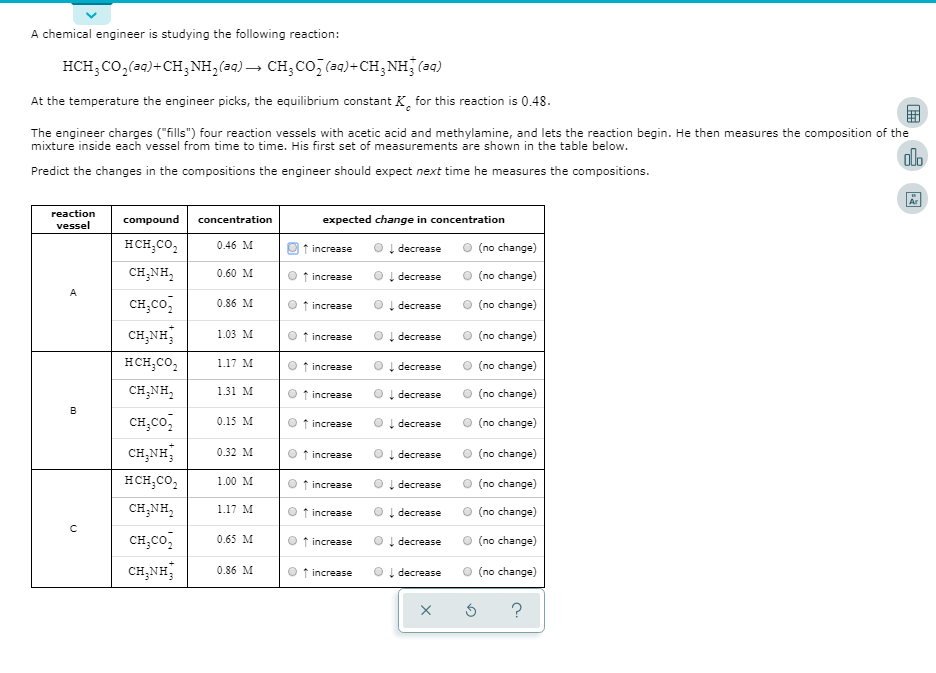A chemical engineer is studying the following reaction: HCH; CO,(aq)+CH;NH,(aq)– CH;Co, (aq)+CH;NH (aq) At the temperature the engineer picks, the equilibrium constant K, for this reaction is 0.48. The engineer charges ("fills") four reaction vessels with acetic acid and methylamine, and lets the reaction begin. He then measures the composition of the mixture inside each vessel from time to time. His first set of measurements are shown in the table below. olo Predict the changes in the compositions the engineer should expect next time he measures the compositions. reaction vessel compound concentration expected change in concentration нсн,со, 0.46 M ↑ increase Į decrease (no change) CH;NH, 0.60 M f increase I decrease (no change) сн, со, O (no change) 0.86 M f increase I decrease CH,NH, O (no change) 1.03 M f increase I decrease HCH;CO, 1.17 M I decrease (no change) ↑ increase CH;NH, 1.31 M f increase I decrease (no change) в сн, со, 0.15 M f increase I decrease (no change) CH;NH, 0.32 M f increase I decrease O (no change) нсн,со, 1.00 M ↑ increase I decrease (no change) CH;NH, 1.17 M f increase I decrease (no change) CH,Co, 0.65 M ↑ increase I decrease (no change) CH,NH, 0.86 M ↑ increase decrease (no change)
A chemical engineer is studying the following reaction: HCH; CO,(aq)+CH;NH,(aq)– CH;Co, (aq)+CH;NH (aq) At the temperature the engineer picks, the equilibrium constant K, for this reaction is 0.48. The engineer charges ("fills") four reaction vessels with acetic acid and methylamine, and lets the reaction begin. He then measures the composition of the mixture inside each vessel from time to time. His first set of measurements are shown in the table below. olo Predict the changes in the compositions the engineer should expect next time he measures the compositions. reaction vessel compound concentration expected change in concentration нсн,со, 0.46 M ↑ increase Į decrease (no change) CH;NH, 0.60 M f increase I decrease (no change) сн, со, O (no change) 0.86 M f increase I decrease CH,NH, O (no change) 1.03 M f increase I decrease HCH;CO, 1.17 M I decrease (no change) ↑ increase CH;NH, 1.31 M f increase I decrease (no change) в сн, со, 0.15 M f increase I decrease (no change) CH;NH, 0.32 M f increase I decrease O (no change) нсн,со, 1.00 M ↑ increase I decrease (no change) CH;NH, 1.17 M f increase I decrease (no change) CH,Co, 0.65 M ↑ increase I decrease (no change) CH,NH, 0.86 M ↑ increase decrease (no change)
Chemistry for Engineering Students
4th Edition
ISBN:9781337398909
Author:Lawrence S. Brown, Tom Holme
Publisher:Lawrence S. Brown, Tom Holme
Chapter12: Chemical Equilibrium
Section: Chapter Questions
Problem 12.41PAE: Because calcium carbonate is a sink for CO32- in a lake, the student in Exercise 12.39 decides to go...
Related questions
Question

Transcribed Image Text:A chemical engineer is studying the following reaction:
HCH; CO,(aq)+CH;NH,(aq)– CH;Co, (aq)+CH;NH (aq)
At the temperature the engineer picks, the equilibrium constant K, for this reaction is 0.48.
The engineer charges ("fills") four reaction vessels with acetic acid and methylamine, and lets the reaction begin. He then measures the composition of the
mixture inside each vessel from time to time. His first set of measurements are shown in the table below.
olo
Predict the changes in the compositions the engineer should expect next time he measures the compositions.
reaction
vessel
compound
concentration
expected change in concentration
нсн,со,
0.46 M
↑ increase
Į decrease
(no change)
CH;NH,
0.60 M
f increase
I decrease
(no change)
сн, со,
O (no change)
0.86 M
f increase
I decrease
CH,NH,
O (no change)
1.03 M
f increase
I decrease
HCH;CO,
1.17 M
I decrease
(no change)
↑ increase
CH;NH,
1.31 M
f increase
I decrease
(no change)
в
сн, со,
0.15 M
f increase
I decrease
(no change)
CH;NH,
0.32 M
f increase
I decrease
O (no change)
нсн,со,
1.00 M
↑ increase
I decrease
(no change)
CH;NH,
1.17 M
f increase
I decrease
(no change)
CH,Co,
0.65 M
↑ increase
I decrease
(no change)
CH,NH,
0.86 M
↑ increase
decrease
(no change)
Expert Solution
This question has been solved!
Explore an expertly crafted, step-by-step solution for a thorough understanding of key concepts.
This is a popular solution!
Trending now
This is a popular solution!
Step by step
Solved in 2 steps with 2 images

Recommended textbooks for you

Chemistry for Engineering Students
Chemistry
ISBN:
9781337398909
Author:
Lawrence S. Brown, Tom Holme
Publisher:
Cengage Learning

Chemistry: The Molecular Science
Chemistry
ISBN:
9781285199047
Author:
John W. Moore, Conrad L. Stanitski
Publisher:
Cengage Learning


Chemistry for Engineering Students
Chemistry
ISBN:
9781337398909
Author:
Lawrence S. Brown, Tom Holme
Publisher:
Cengage Learning

Chemistry: The Molecular Science
Chemistry
ISBN:
9781285199047
Author:
John W. Moore, Conrad L. Stanitski
Publisher:
Cengage Learning


Chemistry
Chemistry
ISBN:
9781305957404
Author:
Steven S. Zumdahl, Susan A. Zumdahl, Donald J. DeCoste
Publisher:
Cengage Learning

Chemistry: An Atoms First Approach
Chemistry
ISBN:
9781305079243
Author:
Steven S. Zumdahl, Susan A. Zumdahl
Publisher:
Cengage Learning

Introductory Chemistry: A Foundation
Chemistry
ISBN:
9781285199030
Author:
Steven S. Zumdahl, Donald J. DeCoste
Publisher:
Cengage Learning